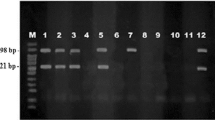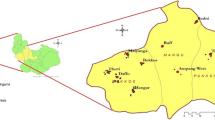Abstract
The present study was carried out to determine the prevalence of Theileria annulata in large ruminants in Southern Punjab (Pakistan). Blood samples were collected from 144 large ruminants, consisting of 105 cattle and 39 buffaloes, from six districts of Southern Punjab including Multan, Layyah, Muzaffar Garh, Bhakar, Bahawalnagar, and Vehari. Data on the characteristics of the animals and herds were collected through questionnaires. The age of animals (P = 0.02), presence of ticks on animals (P = 0.02), and presence of ticks on dogs associated with herds (P = 0.05) were among the major risk factors involved in the spread of tropical theileriosis in the study area. Two different parasite detection techniques, PCR amplification and screening of Giemsa-stained slides, were compared, and it was found that PCR amplification is a more sensitive tool (19% parasite detection) as compared to smear scanning (3% parasite detection) for the detection of T. annulata. Twenty eight out of 144 animals produced the 721-bp fragment specific for T. annulata from five out of six sampling districts. Different blood (hemoglobin, glucose) and serum (ALT, AST, LDH, cholesterol) parameters of calves and cattle were measured and compared between parasite-positive and parasite-negative samples to assess the effect of T. annulata on the blood and serological profile of infected animals.
Similar content being viewed by others
References
Altay K, Aydin MF, Dumanli N, Aktas M (2008) Molecular detection of Theileria and Babesia infections in cattle. Vet Parasitol 158:295–301
Ananda KJ, D’Souza PE, Puttalakshmamma GC (2009) Prevalence of haemoprotozoan diseases in crossbred cattle in Bangalore north. Vet World 2:15–16
Bazarusanga T (2008) The epidemiology of theileriosis in Rwanda and implications for the control. PhD thesis, Dept. Vet Med, Ghent University, Rwanda
Bhoora R, Franssen L, Oosthuizen MC, Guthrie AJ, Zweygarth E, Penzhorn BL, Jongejan F, Collins NE (2009) Sequence heterogeneity in the 18S rRNA gene within Theileria equi and Babesia caballi from horses in South Africa. Vet Parasitol 159:112–120
Col R, Uslu U (2007) Changes in selected serum components in cattle naturally infected with Theileria annulata. Bull Vet Inst Pulawy 51:15–18
Criado A, Martinez AJ, Buling A, Barba JC, Merino S, Jefferies R, Irwin PJ (2006) New data on epizootiology and genetics of piroplasms based on sequences of small ribosomal subunit and cytochrome b genes. Vet Parasitol 142:238–247
Das G, Ghosh S, Ray DD (2005) Reduction of Theileria annulata infection in ticks fed on calves immunized with purified larval antigens of Hyalomma anatolicum anatolicum. Trop Anim Health Prod 37:345–361
Dumanli N, Aktas M, Cetinkaya B, Cakmak A, Koroglu E, Saki CE, Erdogmus Z, Nalbantoglu S, Ongor H, Simsek S, Karahan M, Altay K (2005) Prevalence and distribution of tropical theileriosis in eastern Turkey. Vet Parasitol 127:9–15
Durrani AZ, Kamal N, Khan MS (2006) Incidence of theileriosis and estimation of packed cell volume, total erythrocyte count and hemoglobin in buffaloes. J Anim Pl Sci 16:85–88
Durrani AZ, Mehmood N, Shakoori AR (2010) Comparison of three diagnostic methods for Theileria annulata in Sahiwal and Friesian cattle in Pakistan. Pak J Zool 42:467–472
Forsyth LMG, Minns FC, Kirvar E, Adamson RE, Hall FR, McOrist S, Brown CGD, Preston PM (1999) Tissue damage in cattle infected with Theileria annulata accompanied by metastasis of cytokine producing, schizont-infected mononuclear phagocytes. J Comp Pathol 120:39–57
Geerts S, Holmes PH, Diall O, Eisler MC (2001) African bovine theileriosis: the problem of drug resistance. Trends Parasitol 17:25–28
Ghosh S, Bansal GC, Gupta SC, Ray D, Khan MQ, Irshad H, Shahiduzzaman M, Seitzer U, Ahmed JS (2007) Status of tick distribution in Bangladesh, India and Pakistan. Parasitol Res 101:207–216
Gubbels MJ, d’Oliveira C, Jongejan J (2000) Development of an indirect Tamsl enzyme-linked immunosorbent assay for diagnosis of Theileria annulata infection in cattle. Clin Diagn Lab Immunol 7:404–411
Hasanpour A, Moghaddam GA, Nematollahi A (2008) Biochemical, hematological, and electrocardiographic changes in buffaloes naturally infected with Theileria annulata. KJ Parasitol 46:223–227
Hussain SI (1980) Studies of ectoparasites of livestock of Sindh. Final Tech Report. Univ Sindh, Jamshoro, Sindh
Kirvar E, Ilhan T, Katzer F, Hooshmand-Rad P, Zweygarth E, Gerstenberg C, Phipps P, Brown CGD (1999) Detection of Theileria annulata in cattle and vector ticks by PCR using the Tams1 gene sequences. Parasitology 120:245–254
Kosar MH (1965) Taxonomy and bionomics of the species of genus Rhipicephalus. MSc Thesis, Dept Vet Parasitol, Univ Agri, Faisalabad, Pakistan
Livestock Census (1996) Data on Punjab Livestock, Livestock Census Organization, Govt. of Punjab
Madder M, Taeymans J (2001). Merogony in vitro cultures of Theileria parva. In: The 18th International Conference of the World Association for the Advancement of Vet. Parasitology in Italy. pp. 26–30
Martin-Sanchez J, Viseras J, Adroher FJ, Garcia-Fernandez P (1999) Nested polymerase chain reaction for detection of Theileria annulata and comparison with conventional diagnostic techniques: its use in epidemiology studies. Parasitol Res 85:243–245
Nazifi S, Razavi SM, Mansourian M, Nikahval B, Moghaddam M (2008) Studies on correlations among parasitaemia and some hemolytic indices in two tropical diseases (theileriosis and anaplasmosis) in Fars province of Iran. Trop Anim Health Prod 40:47–53
Oliveira DC, Van Der Weide M, Habela MA, Jacquiet P, Jongejan F (1995) Detection of Theileria annulata in blood samples of carrier cattle by PCR. J Clin Microbiol 33:2665–2669
Qayyum M, Farooq U, Samad HA, Chauhdry HR (2010) Prevalence, clinicotherapeutic and prophylactic studies on theileriosis in district Sahiwal (Pakistan). J Anim Plant Sci 20:266–270
Rady AA, Ahmed LS, Mohamed A, Hosary AA (2010) Using polymerase chain reaction (PCR) for diagnosis of bovine theileriosis in upper Egypt. IJAVMS 4:67–74
Rehman WU, Khan IA, Qureshi AH, Hussain S (2004) Prevalence of different species of ixodidae (hard ticks) in Rawalpindi and Islamabad. Pakistan J Med Res 43
Shaikh R, Ramzan K, Nazil S, Sattar S, Khan SN, Raizuddin S, Ahmed ZM, Friedman TB (2005) A new locus for nonsyndromic deafness DFNB51 maps to chromosomes 11p 13-p12. Am J Med Genet A 138:295–392
Singh A, Singh J, Grewal AS, Brar RS (2001) Studies on some blood parameters of crossbred calves with experimental Theileria annulata infection. Vet Res Commun 25:289–300
Soulsby EJL (1982) Helminths, arthropods and protozoa of domesticated animals. Bailliere, London
The Center for Food Security and Public Health (2005) Animal disease fact sheet. The Center for Food Security and Public Health, Iowa State University
Theodoropoulos G, Gazouli M, Ikonomopoulos JA, Kantzoura V, Kominakis A (2006) Determination of prevalence and risk factors of infection with Babesia in small ruminants from Greece by polymerase chain reaction amplification. Vet Parasitol 135:99–104
Yadav CK, Sharma NN (1986) Changes in blood chemical components during experimentally induced Theileria annulata infections in cattle. Vet Parasitol 21:91–98
Acknowledgments
This project was financed by the Directorate of Research and External Linkages, Bahauddin Zakariya University, Multan (Pakistan). The authors would like to thank all the veterinarians for their kind help during sample collection.
Author information
Authors and Affiliations
Corresponding author
Rights and permissions
About this article
Cite this article
Shahnawaz, S., Ali, M., Aslam, M.A. et al. A study on the prevalence of a tick-transmitted pathogen, Theileria annulata, and hematological profile of cattle from Southern Punjab (Pakistan). Parasitol Res 109, 1155–1160 (2011). https://doi.org/10.1007/s00436-011-2360-1
Received:
Accepted:
Published:
Issue Date:
DOI: https://doi.org/10.1007/s00436-011-2360-1




